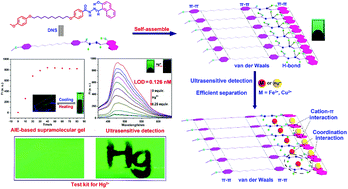Recently, ultrasensitive stimuli-responsive materials have received extensive attention due to their high sensitivity and wide applications. Herein, we report a novel approach to design ultrasensitive responsive materials by rationally introducing the aggregation-induced emission (AIE) effect into supramolecular polymer gels. According to this approach, by rationally introducing self-assembly moieties and a fluorophore, the obtained gelator DNS can act as an AIEgen; it showed strong AIE after aggregating into the supramolecular polymer gel GDNS. More interestingly, because the aggregation of DNS led to amplification of the detective signal, the AIE-based supramolecular polymer gel GDNS could ultrasensitively detect the heavy metal ions Hg2+, Cu2+, and Fe3+ by a signal amplification mechanism; the lowest detection limits reached 10−11 M. In addition, the xerogel of GDNS could adsorb and separate Hg2+, Cu2+, and Fe3+ from aqueous solution with favourable adsorption properties, and the adsorption rates ranged from 94.70% to 99.37%. Furthermore, the gel GDNS could act as a convenient test kit for Hg2+, Cu2+, and Fe3+ as well as a smart fluorescent display material.
